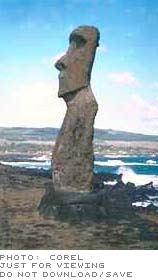|
Easter Island, a Chilean province in the Valparaiso Region V, is located in the Pacific Ocean, 3,600 km from South America’s seashore; 3,700 km from Tahiti; and 2,600 km from the nearest inhabited town, Mangareva on the Gambier archipelago of Polynesia. Easter Island, Rapa Nui as it is called in the local dialect, is thought to have been colonized over 1500 years ago by Polynesian sailors.
From remote origins, the isolated Rapa Nui community has been able to withstand depredation from man and in spite of it, create and sustain an outstanding culture whose most important material expression are the world famous megalithic sculptures in the island. Discovered for westerners in 1722 by Roggeveen, Rapa Nui was visited by all famous expeditionary missions at the time. Internal wars and fighting slowly eroded the original island population. Afterwards, slave traders came and virtually made the remaining people disappear. They were followed by all kinds of clergymen, adventurers, and businessmen until Captain Policarpo Toro took possession of the island in 1888 on behalf of the Chilean Government. A confusing time followed with claims from inheritors and different companies with relative stability when the island was assigned as a large sheep ranch to the “Cia. Explotadora de la Isla de Pascua” owned by Williamson, Balfour & Company.
At present, tourism is the main economic activity at Rapa Nui, a National Park, declared Heritage of Mankind by UNESCO in 1996. Today, the big island mysteries continue unsolved. Where did the original inhabitants come from? Was it from Polynesia? From South America? Botanists have shown that sweet potatoes are originally from South America. Why were they found in the island? The stone walls, surprisingly similar to Inca works, indicate a possible Peruvian origin or, at least, some kind of relationship.
What was the meaning of the more than 600 colossal statues characteristic of the island? How were they carried from the volcano to their present position? And how were they raised considering they weigh several tons and they are as high as 21 meters? Whatever the reason, with problems just as any other community all over the world, island inhabitants have shown their capacity to overcome adversity over the centuries. Today, Rapa Nui people, proud to be Chilean citizens, renew their will to work for their future in the modern world, without rejecting their ancestor roots. The Easter Island people, an example of the best of the latin spirit. |
|
|
 Can
a South American province be more than 2,600 km away from the nearest
inhabited place?
Can
a South American province be more than 2,600 km away from the nearest
inhabited place?